The chicken egg gives structure to dishes. They can act as binding and leavening agents. They emulsify with fat, and they contribute to color and flavor. These are only a few functional properties of the chicken egg.
This chicken egg guide will answer the most basic questions you might have about the chicken egg. The chicken egg is so diverse that this is the first of a series of articles on eggs. Questions you might have about soufflés, meringues, macarons, or emulsion sauces (e.g. hollandaise) will have to wait a bit.
What you’ll get from this guide about the chicken egg
- An introduction to the agricultural aspects of the chicken egg.
- An introduction to the nutritional and chemical aspects of the chicken egg.
- An introduction to the basic culinary uses of the chicken egg.
We interviewed two experts to ask about the agricultural, nutritional, and basic chemical aspects of the chicken egg:
David Webb, marketing and communications manager of the Egg Farmers of Alberta in Canada.
Dr. John Brunnquell, CEO and president of Egg Innovations in Warsaw, Indiana, USA. He has a Master’s degree in Poultry Science and a Ph.D. in Avian Ethology from the University of Kentucky. He focused on the study of natural chicken behaviors.
David answered our questions about the agricultural, nutritional, and chemical aspects of the chicken egg. John helped with the agricultural aspects and other poultry science-related questions.
What makes an egg a free-range egg?
David: Free-range eggs come from laying hens that farmers house in a free-run barn. That means they are free to roam about the barn with access to feed, water, perches, and nest boxes. They also have access to outdoor runs when the weather permits.
John: In the United States we define it as hens having routine access to an outdoor pasture. There are multiple certifiers who have somewhat different standards. Humane Farmed Animal Care requires 2 ft (0,6 meters) per hen of outside pasture space. American Humane requires 21,8 ft (6,6 meters) per hen of outside pasture space.
What makes a chicken egg organic?
David: Organic eggs come from laying hens that farmers house in a free-run barn. Their living conditions should be the same as the requirements for a free-range chicken. They are only fed certified organic feed. They make organic feed from crops that farmers do not treat with herbicides or pesticides.
John: Hens are fed an organic diet from day 2 of life. There is controversy in the United States on outside access. Approximately 50% of the market lets their organic hens on pasture and the other half keeps them confined in a cage-free setting. The Organic Trade Association filed a lawsuit against the government to resolve this issue. The Organic Trade Association wants all organic hens required to have outside access to the soil. We are firm believers that letting hens outside is a good thing.
What’s the difference between white and brown eggs?
David: There is no real difference between white and brown eggs. It’s only the color on the outside of the shell that’s different. White birds lay white eggs and brown birds lay brown eggs. Technically speaking, you need to check the color of a hen’s earlobes to determine whether the egg will be white or brown.
John: The parental genetics determine if a hen is going to lay a white or a brown egg, or any other color for that matter. Nutritionally the white and brown eggs are very similar in profile.
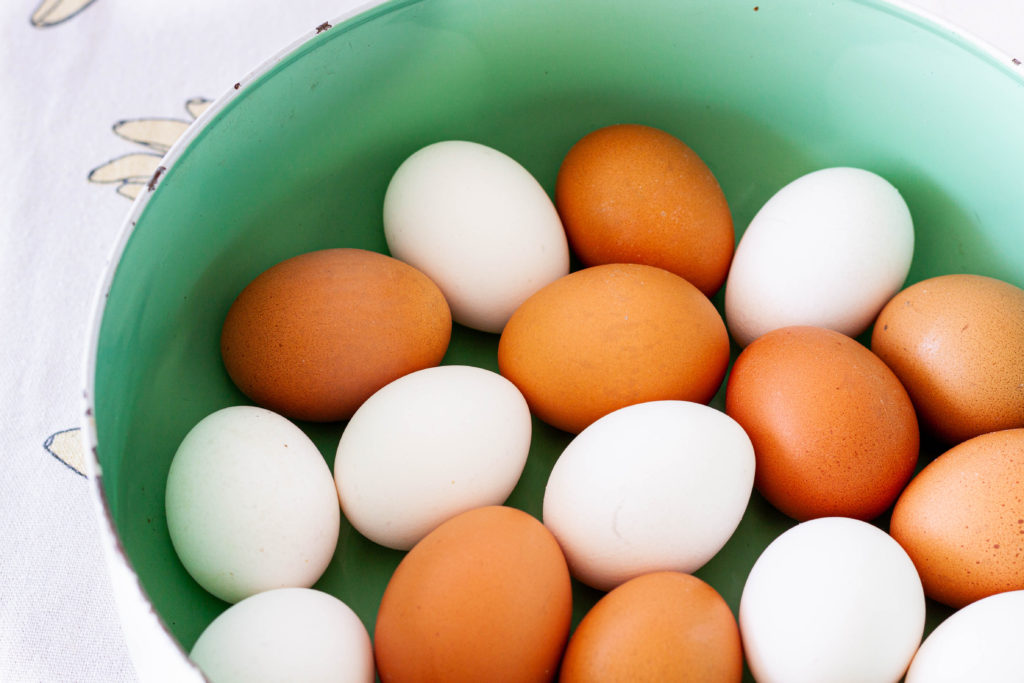
Photo: Hannes Kruger
Why are eggs different sizes?
David: The size of an egg is dependent on the age of the laying hen. Hens tend to lay more small eggs (peewee, small, and medium-sized eggs) when they first start laying around 19 weeks of age. Then they will start laying larger eggs (large, extra large, and the odd jumbo-sized eggs) as they mature and get accustomed to laying eggs.
John: When a hen starts producing eggs (17-week-old), her eggs are smaller in size (40 gms). As the hen gets older, the size of the egg gets larger (60 gms). Consumers generally want a uniform size in their egg cartons. So the eggs must go through a sorting machine to put similar size eggs in the same carton.
How do they grade eggs?
David: All eggs sold at retail must be graded at a grading station. The Canadian Food Inspection Agency (CFIA) must certify those stations. At the grading station, they wash the eggs, and then they inspect (via a process called candling) the eggs. After the inspection, they grade (weigh) the eggs and then only put them in their packaging.
John: The major brands of egg graders are Sanova, Staalkat, and Moba. All of them follow the same principle. They load eggs into the machine from the henhouse. Then they wash and dry the eggs. After that, they remove the imperfections such as leakers and cracked eggs. Eggs then go through a UV light for food safety and finally are weighed and transferred to cartons. Then they give the carton a code so the producer can trace the origins of the egg.
What causes double yolk eggs?
David: Double-yolk eggs are most common in younger laying hens who are just starting to lay eggs. Once in a while a hen will release two eggs in the time it takes her to form the shell. It typically takes a hen around 30 hours to produce one fully formed egg.
John: Double yolks occur for two reasons. The first occurs when the hen starts to lay eggs. In simple terms, the yolk production is not aligned with the shell production, and two yolks are deposited into one shell. At the other end of the spectrum, when a hen is old, the shell-forming process might go slowly. That will allow a second yolk to enter the shell before it is fully formed. The key to note is an egg is formed from the inside out. First, the yolk is produced and then a shell is wrapped around it.
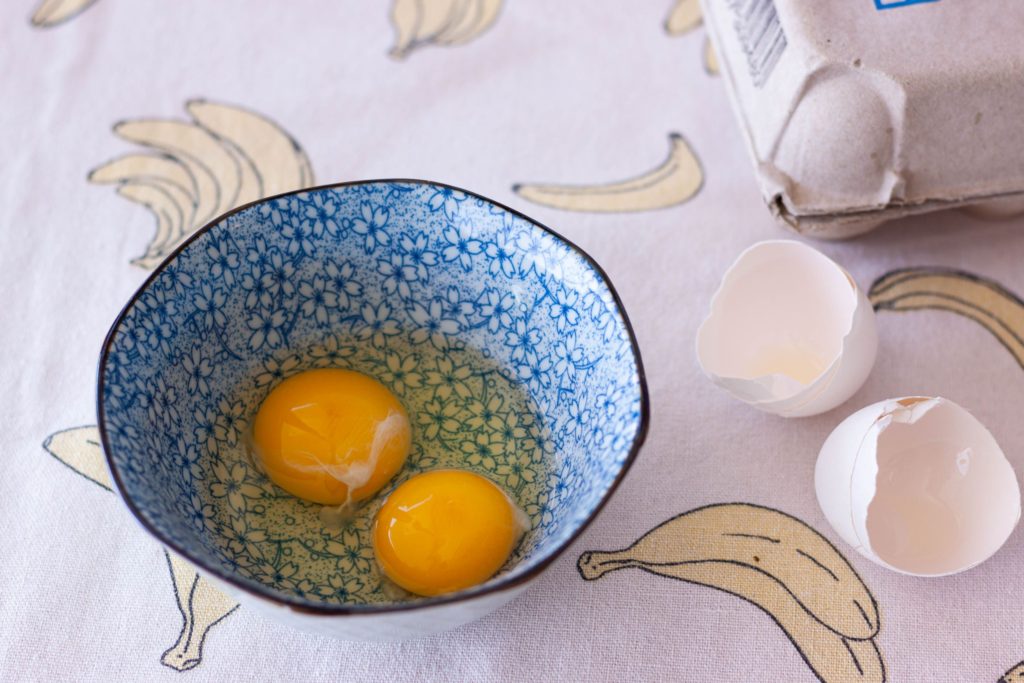
Photo: Hannes Kruger
What causes yolks to be different colors?
David: The color of an egg’s yolk is entirely dependent on the hen’s feed. A wheat-based diet (western Canada) will produce lighter yolks. A corn-based diet (eastern or central Canada) will produce darker yolks. Free-range and organic eggs also tend to have darker yolks. That is because the hens are able to eat grass, bugs, and anything else they can while they are outside.
John: Many things can affect yolk color including age, health, temperature, and genetics. The most common influencer is diet. The hen absorbs the dark colors that it eats into its body and then passes this pigment to the yolk. Consequently, hens in pasture tend to have darker yolks than hens in cages.
Should I keep my eggs refrigerated?
David: In Canada, they strongly recommend that people refrigerate their eggs immediately after they have bought them at the supermarket. Store it in the central part of the fridge (not in the door). That is to ensure maximum freshness to the best-before date and beyond. Since the egg’s natural coating is removed at the grading station during the washing process, the eggs can absorb smells/flavors more easily and will not stay at peak freshness for as long as they would with its natural coating. The central part of the fridge helps ensure a more consistent temperature during storage.
John: When the egg is laid the hen puts a waxy layer around the egg to protect it. If the eggs are not washed, they are safe at room temperature for several weeks. They are also safe if the eggs are cooked at 130°F (55°C) for more than 60 seconds. This will kill any potential food-borne bacteria. The opinion on refrigeration of shell eggs varies around the world.
Why do some egg yolks have a red spot?
David: Some egg yolks will occasionally have red spots, which are actually blood spots, due to the hen straining and breaking a blood vessel while laying the egg. Eggs with large and/or multiple blood spots will be removed from the food supply chain during the inspection process at the grading station. Those eggs will be sent for further processing.
John: Eggs can have a red spot for several reasons. The most common in white eggs is a blood spot. While it is unattractive, there are no nutritional or food safety concerns. The phenomena are very similar to a person bruising their skin. In brown hens, we generally see pigment spots. It’s often confused with blood spots, but it’s something entirely different. The last gland an egg goes through in a brown hen is the pigment gland. The shell actually starts out white inside of the hen and then is coated with a brown pigment before it is released from the hen. Sometimes this brown pigment can migrate up the oviduct and small brown flecks can land on the yolk before the shell is wrapped around the egg.
What does the printed code on eggs mean?
David: The printed code on the carton provides details about where the eggs come from (the grading station) and when the eggs were graded and packaged.
John: The coding requirements vary by country, but they all serve the same purpose. It is important to know the age of the eggs in the carton and to be able to trace back the eggs to the farm if there is ever a food safety issue.
What do laying hens eat?
David: Laying hens in Canada are typically fed either a wheat or corn-based diet, which will often include a mix of crops grown on a farm such as barley, alfalfa, canola, canola oil, flaxseed, and peas.
John: Diets vary by country based on available ingredients. In the United States, about 60% of the diet is corn; 30% soybean meal; and 10% calcium, vitamins, and minerals.
Are hens given steroids or hormones?
David: Laying hens in Canada are never fed added hormones or steroids, as has been the case for more than 40 years. It is actually illegal to feed laying hens either hormones or steroids.
John: No, they are not.
How many eggs does a hen lay?
David: A mature laying hen will typically lay an egg about every 30 hours, or about 300 eggs per year on average.
John: A high-producing hen can lay 500 eggs in 83 weeks.
What different types of hens are there?
David: While there are many different breeds and types of chickens, the layer industry tends to use leghorns, including breeds like Dekalb, Lohmann, Babcock, Shaver, and Hyline, to name a few.
John: There are many species of hens. The most common egg production derives from the Rhode Island Red for brown eggs and the leghorn for white eggs.
Are the chickens they use for eggs the same as chickens they use for meat?
David: The egg industry (laying hens) uses chickens that are more on the lean and athletic side, while the chicken industry (broilers) uses chickens that naturally gain more weight. There are many breeds of chickens that they are using as dual-purpose birds. However, neither the egg nor the chicken industry prefers to use them because they are not as efficient at laying eggs or gaining weight.
John: No. They are entirely different animals. The chicken you put on a grill will have a 6 to 8-week life before they harvest them. A laying hen will produce for up to 2 years.

Photo: supplied
What’s the environmental impact of producing eggs?
David: The environmental impact of the egg industry depends on the type of hen housing that farmers are using and a wide variety of design, construction, technology, and management decisions made by the farmer. Alberta is the first province in Canada to implement an on-farm environmental program called PEEP (Producer Environmental Egg Program), which monitors each farm’s management of energy use (electricity & gas), water, manure, and waste.
How do you know which size a hen will lay?
David: The size of eggs can be peewee (less than 42 grams), small (at least 42 g), medium (at least 49 g), large (at least 56 g), extra large (at least 63 g), or jumbo (70 g or more). When laying hens first start laying eggs around 19 weeks of age, they tend to produce smaller eggs, then produce larger eggs as they mature.
What’s the nutritional value of an egg?
David: Eggs are one of nature’s most nutrient-dense eggs. One large egg contains 6 grams of protein, along with many vitamins and nutrients such as iron, choline, lutein, and vitamins A, B12, D, and E.
Do eggs increase the risk of heart disease?
David: The cholesterol in eggs is dietary cholesterol, which has little effect on most people’s blood cholesterol. Excess saturated or trans fats are far more concerning than dietary cholesterol, so there is no reason for a healthy, low-risk person to limit their egg consumption.
How many calories are there in an egg?
David: A single large egg contains just 70 calories.
Can we eat raw eggs? Why or why not?
David: The recommendation is that you should cook your eggs thoroughly to maximize food safety assurance and minimize the risk of contamination. For a healthy person who takes care in handling and storing their eggs, consuming a raw or semi-cooked egg should not pose a significant risk.
How can I tell if my egg is fresh?
David: If you store your eggs properly in the main body of the fridge, they should remain fresh until at least a week beyond the best before date printed on the egg carton. You can also check an egg’s freshness by dropping an egg in a glass of water; if it sinks it is at peak freshness. The egg shell’s pores absorb air, causing the air cell in an egg to grow over time. That means an older egg will float. Less fresh eggs are better if you like your eggs hard-boiled since they are fully cooked and will be much easier to peel than a fresh egg.
What causes an egg yolk to be blue-ish in color when you boil an egg too long?
David: An egg can sometimes appear blue when overcooked due to a chemical reaction from the sulfur (egg white) and iron (egg yolk) in the egg, or from water that has an unusually high amount of iron in it.
Basic culinary uses of the chicken egg
Meg Tucker, cooking class instructor and host of a Canadian educational cooking TV show for kids, shared how she approaches the basic culinary uses of the chicken egg.
How do you make scrambled eggs?
In a small frying pan, add a tablespoon of butter, with a teaspoon of oil (the oil is optional, but it sometimes helps everything come together nicely without the butter browning too much). Turn the heat to medium-low. We want to be patient when we scramble, without getting too much color on the eggs. In a bowl, crack and whisk your eggs; there really is no need to add extras like cream or milk. Once the heat is medium-low, pour your eggs in and gently mix it around in the pan with a nonstick or silicone spatula until cooked. At the last minute, you can add one more little dab of butter, to make them shiny and even more delicious, with a crack of pepper and a pinch of salt.
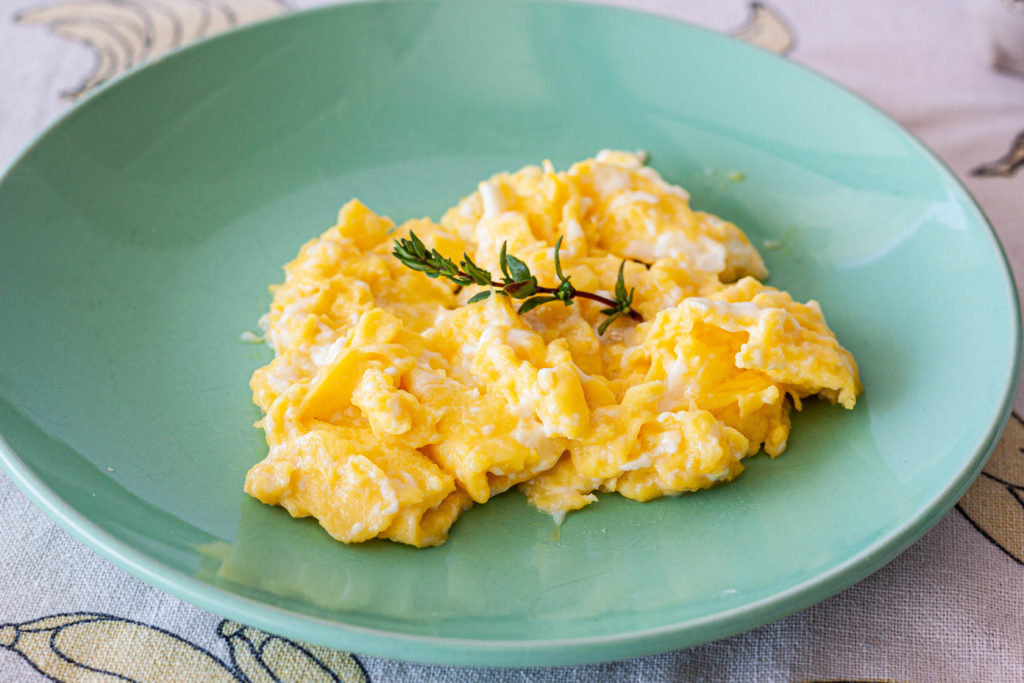
Photo: Hannes Kruger
How do you fry an egg?
The best way to fry an egg is with a small frying pan on medium to medium-low heat. A liberal amount of fat in the pan, and then a lid over the top to help create a “convection” steam circle to help cook and set the egg whites.
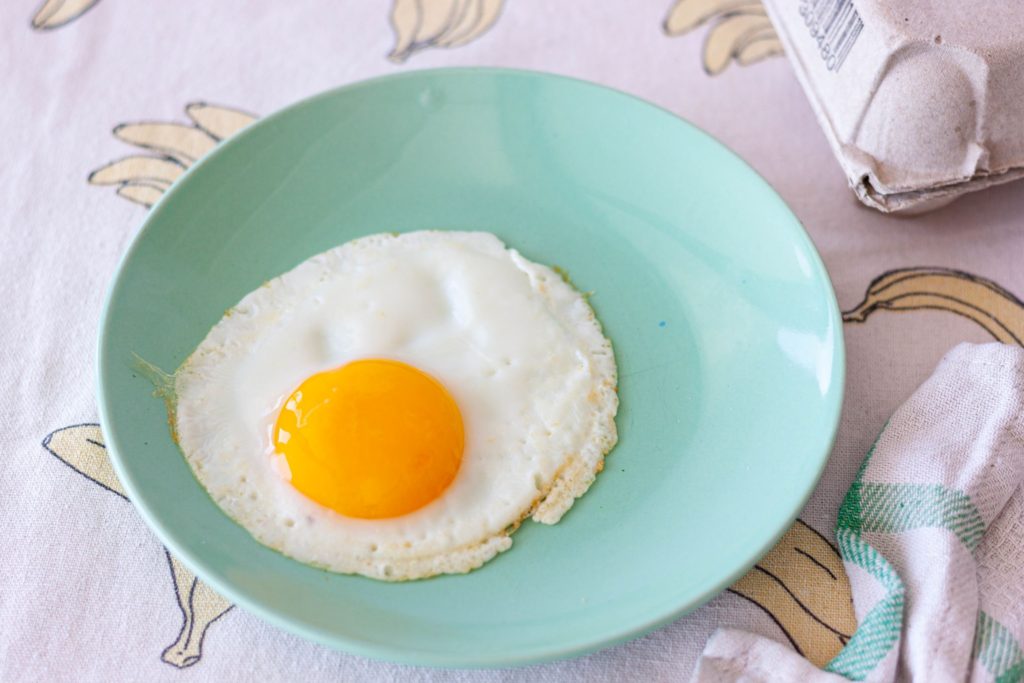
Photo: Hannes Kruger
How do you poach an egg?
There are many ways to poach an egg, but the easiest without any special equipment is a large frying pan or wide saucepan. Fill ¾ of the way with water. Crack your egg into a small bowl, then once your water is at a simmer (just below a boil), slowly lower the egg into the water without disturbing it. Let it cook until the whites are no longer jiggly. For a soft runny egg yolk, cook for about 3 to 4 minutes. Remove the eggs gently from the water with a slotted spoon and place them onto a paper towel-lined plate before serving to blot excess water from the eggs. Serve immediately.
How do you cook eggs in the microwave?
Grease a small oven-safe bowl, ramekin, mug, or ceramic egg maker with the oil of your choice — any oil you like works. Crack the eggs into the bowl and whisk them with a fork until they’re combined. Season with salt and pepper. Microwave on high for 30 seconds.
How do you boil an egg?
Place your eggs in a single layer on the bottom of your pot and cover with cold water. Turn the heat to high and bring your eggs to a rolling boil, then remove from the heat, cover, and let sit in the hot water for about 10 minutes for large eggs to become hard (6 minutes to make the whites set with a runny yolk). Drain water and run under cool water before peeling.
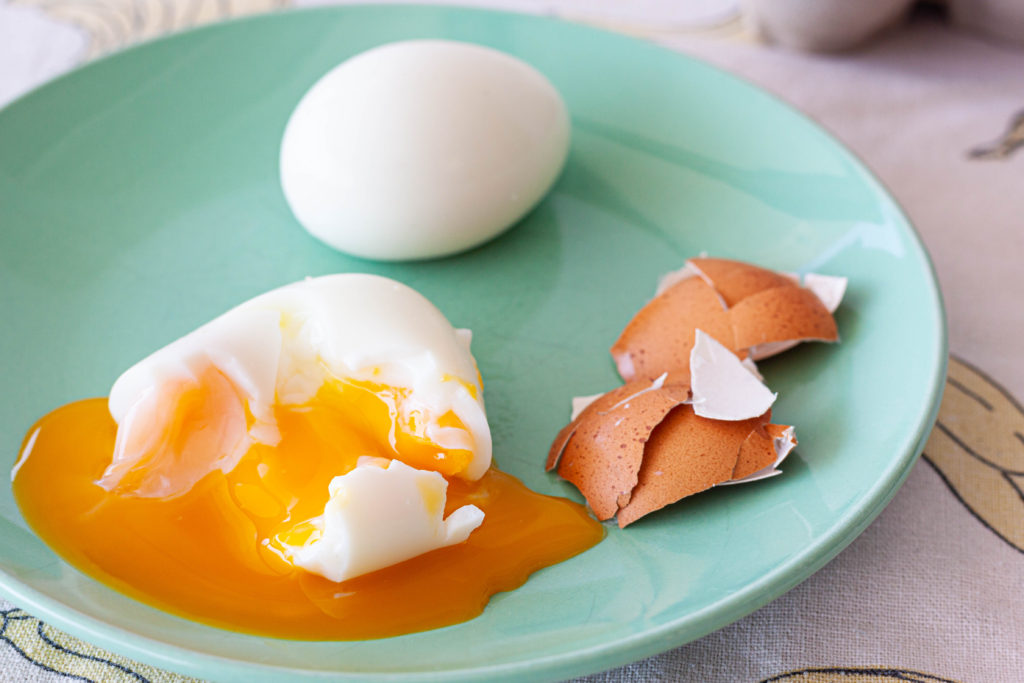
Photo: Hannes Kruger
What are the best vegan substitutes for eggs in baking?
For baking, you can use a few different vegan options as egg replacement: apple sauce, aquafaba (the thick liquid that is in a can of chickpeas), banana, or ground flaxseed with water.




1 thought on “The Chicken Egg”
Loved this article! I have a follow up question, why do egg yolks explode in the microwave? Is there a way to make a “fried” egg in the microwave?